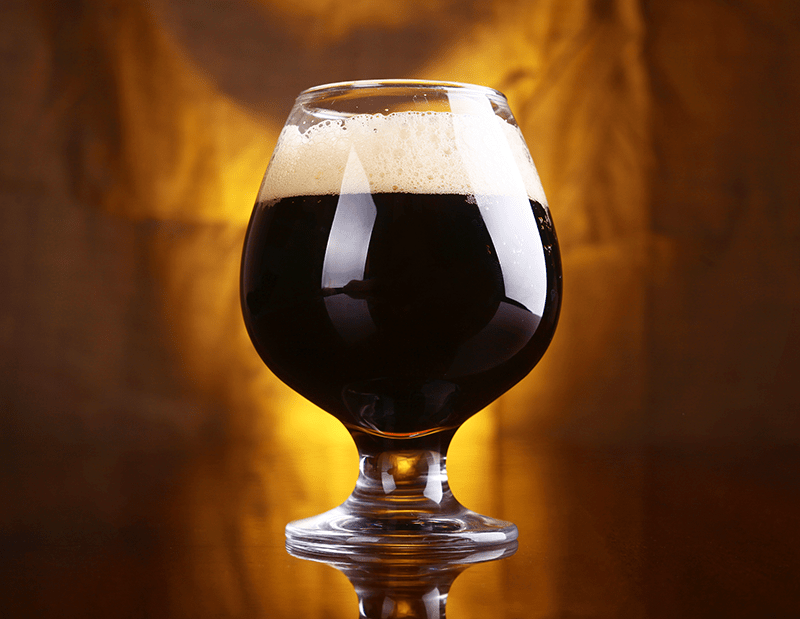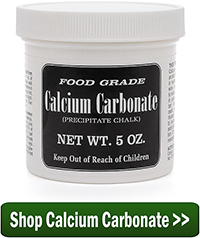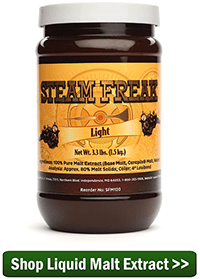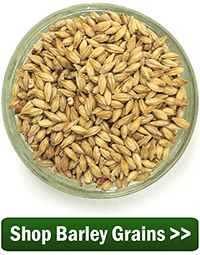 Stouts have always been big brews, but Russian imperial stout is the biggest of the big. From the high gravity, to the complex, roasty malt flavors, to the assertive hoppiness, a Russian imperial stout recipe is not for the faint of heart.
Stouts have always been big brews, but Russian imperial stout is the biggest of the big. From the high gravity, to the complex, roasty malt flavors, to the assertive hoppiness, a Russian imperial stout recipe is not for the faint of heart.
Actually an English style beer, Russian Imperial Stout was made to be exported to the Nordic and Slavic regions of Europe and was reportedly popular with the Russian monarchy. The high gravity and alcohol content helped with the beer’s stability over travel, but also provided warmth in the colder climates. Some fruity, yeast derived esters combine with a malt complexity to create a rich, complex brew sometimes reminiscent of strong port. The beer is often aged for flavor development.
As with many English beer styles, Russian imperial stout has been adopted by American brewers who often make roastier, hoppier versions of the style. BJCP guidelines for Russian imperial stout are as follows:
- OG: 1.075 – 1.115
- FG: 1.018 – 1.030
- ABV: 8 – 12%
- IBUs: 50 – 90
- SRM: 30 – 40+
Tips for Brewing a Russian Imperial Stout Recipe
- To get the gravity needed hit 8-12% ABV, you need a large amount of fermentable ingredients, a minimum of 9-10 pound of malt extract. Even for the all-grain brewer, malt extract can help make the mash a little less of a chore.
- You might consider using alkaline water to compensate for the astringency and acidity of the roasted grains. Some calcium carbonate (food-grade chalk) added to the mash/steeping water can help.
- To balance out the alcohol and intense maltiness, a strong hop schedule is required. If brewing extract or partial mash beer recipe, consider adding half of your malt extract at the end of the boil to help improve hops utilization.
 Use this insanely simple extract beer recipe below to craft your own Russian imperial stout. It’s been somewhat “Americanized” with high alpha hops and some assertive, American hop late additions. We also have a couple Russian imperial stout recipe kits from Brewcraft and Brewer’s Best if you’d like to go that route.
Use this insanely simple extract beer recipe below to craft your own Russian imperial stout. It’s been somewhat “Americanized” with high alpha hops and some assertive, American hop late additions. We also have a couple Russian imperial stout recipe kits from Brewcraft and Brewer’s Best if you’d like to go that route.
Happy brewing!
Motor Oil Russian Imperial Stout Recipe
(Five-gallon batch, extract with specialty grains)
Specs
OG: 1.088
FG: 1.025
ABV: 8.3%
IBUs: 82
SRM: 39
Ingredients
6.6 lbs. Light LME
6.6 lbs. Amber LME (late addition)
1 lb. Chocolate malt (crushed)
.5 lb. Caramel 80L malt (crushed)
.5 lb. Roasted barley (crushed)
1 steeping bag for specialty grains
1.5 oz. Bravo hops at :60
1 oz. Columbus hops at :10
1 oz. Cascade hops at :10
2 packs Safale US-05 ale yeast
Directions
Heat 2.5 gallons of water in the boil kettle to 155-165˚F. Place crushed grains in the steeping bag and steep for 20 minutes. Mix in 6.6 lbs of light LME. Bring wort to a boil. Add Bravo hops and boil for 50 minutes. Add Columbus and Cascade hops and boil for ten minutes. Stir quickly to create a whirlpool, then cool wort to 70˚F using an ice bath or an immersion wort chiller. Pour wort into clean, sanitized fermenter, then top off to make 5.5 gallons. Use a sanitized spoon to mix well, then pitch yeast. Ferment at 70˚F for two weeks, then transfer to secondary for three to four weeks. Bottle and age for 2-4 months or longer.
Cascade hops and boil for ten minutes. Stir quickly to create a whirlpool, then cool wort to 70˚F using an ice bath or an immersion wort chiller. Pour wort into clean, sanitized fermenter, then top off to make 5.5 gallons. Use a sanitized spoon to mix well, then pitch yeast. Ferment at 70˚F for two weeks, then transfer to secondary for three to four weeks. Bottle and age for 2-4 months or longer.
Do you love to brew dark, heavy beers? Try this Uinta Dubhe Imperial Black IPA clone! Do you have a Russian imperial stout recipe? We’d love for you to share it: extract or all-grain!
–—-
David Ackley is a beer writer, brewer, and self-described “craft beer crusader.” He holds a General Certificate in Brewing from the Institute of Brewing and Distilling and is founder and editor of the Local Beer Blog.

Sounds great! Looking forward to giving it a go this a go. However, at what point do you add the Amber LME? It says late addition, but the directions don’t say specifically when to put it in. Thank you!
Northrup, thanks for pointing this out. The late addition malt should be dissolved into the wort at the very end of the boil. In this particular case, add it right after you add the Columbus and Cascade hops. Get it dissolved within that 10 mins. Then whirlpool.
You mentioned the recipe was “Amercianized” to make it hoppier…. I’m likely in the minority, but I don’t particularly care for that Americanization… =) How would I change the recipe if I’d ike to make it “normal” vs “hoppier?
Thanks!
Ross, here are the changes we advise making to this recipe to make it less hoppy. Replace the hops in the original recipe to what we recommend below. If you need further assistance please let us know.
1.5 oz. Galena hops at :60
1 oz. Northern Brewer hops at :30
1 oz. Northern Brewer hops at :10
Thanks! I greatly appreciate the hop adjustment. =)
Awesome!! I too am not a fan of the American Hop crazy. Great question and thanks!
Looking forward to brewing a RIS very soon! I was hoping to get mine up closer to the 10-12% ABV range, though. Would you recommend modifying this recipe or just using a different one designed to produce a higher ABV?
Thank you!
Tim, if you would like to increase the alcohol content of this recipe you can accomplish this by adding more of the Dried Malt Extract. The general rule of thumb is that for every 1.2 pounds of DME that you add it will increase the potential alcohol by about one percent in a five-gallon batch. You can also use corn sugar. Using corn sugar, add one pound for every 5-gallons to raise the potential alcohol by one-percent.
Thanks Ed!
WOW… a Russian imperial stout, that sounds Delish.. will have to give it a try,,
I like the less Hoppy versions, thanks
Hi, I was wondering when or if you put the put the steeping bag full of crushed grains into the fermenter. Or, do you pull it out of the kettle after the 20 minute steep? I’m a noob so please go easy on me!
Derek, it is always better to ask questions if you are unsure! After the boil, you will remove the grain bag, let it drain and discard. Do not squeeze the bag.
you boil the grain bag?
Since this is a partial mash recipe, it does not matter if you leave the grain bag in or out of the kettle when bringing the wort to a boil. If it is one of our grain bags, it will handle boiling temperatures just fine.
Do you need to use any priming sugar for this recipe?
Michal, yes you would need priming sugar for carbonating the beer.
What quantity of priming sugar ?
Jeremy, The article link below will give you information about how much carbonation you want. Typically, you will add 5 ounces of priming sugar to a 5-gallon batch.
Carbonating Homebrew
https://blog.eckraus.com/carbonating-homebrew-bottles-kegs
Greetings! I’ve got a couple of questions.
On the ABV: I’m thinking of upping the lme by an additional 5 pounds to bring the ABV into the 12% range. Thoughts on the ABV jump?
Also, what’s your take on adding adjuncts to this recipe? I was thinking marshmallow
Jesus, yes you can increase the alcohol percent in beer recipes. For more information, please take a look at the article posted below.
Increase The Alcohol In Homebrew
https://blog.eckraus.com/raise-increase-alcohol-content-homebrew
What do y’all think of Willamette for this recipe? I’ve got a spare pound of Willamette and a spare third of a pound of cascade. Is this a fine substitution?
Nate, it is certainly fine to experiment with the different hops. However, we do not know what the flavor outcome will be.
Sounds good especially with modified hop recipe ,do I need to do a secondary fermentation if it’s going into a keg ,thinking once it’s gassed leaving at 35 kpi for a couple of weeks at least
Hi, Ed. I have a question…
It’s stated above, that the target FG is 1.018, to 1.030 for the insanely simple Russian imperial stout. If the FG is so high, will this not create “bottle bombs”, when carbonating this stout, or should we not consider bottling at such a high FG